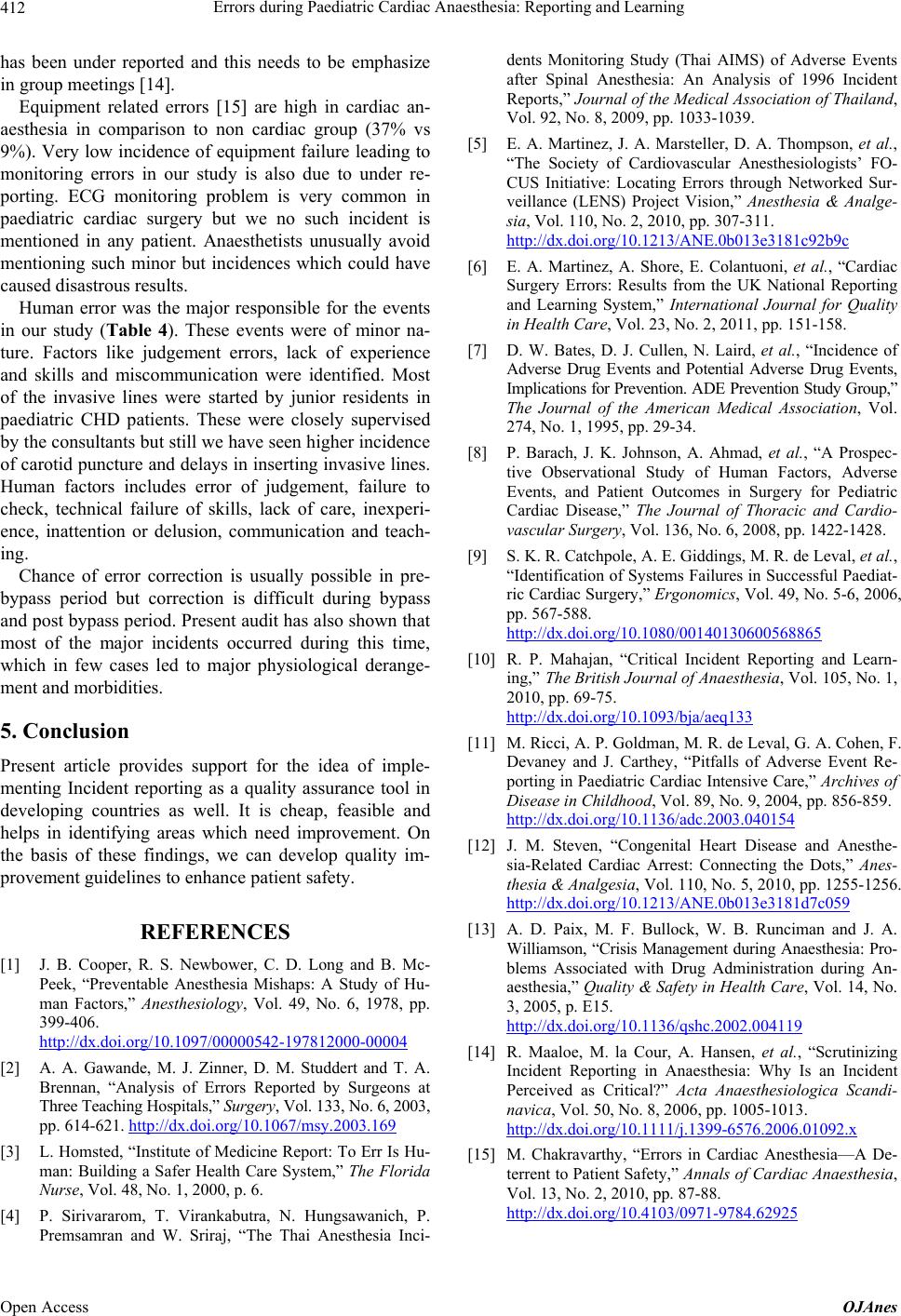
Errors during Paediatric Cardiac Anaesthesia: Reporting and Learning
Open Access OJAnes
412
has been under reported and this needs to be emphasize
in group meetings [14].
Equipment related errors [15] are high in cardiac an-
aesthesia in comparison to non cardiac group (37% vs
9%). Very low incidence of equipment failure leading to
monitoring errors in our study is also due to under re-
porting. ECG monitoring problem is very common in
paediatric cardiac surgery but we no such incident is
mentioned in any patient. Anaesthetists unusually avoid
mentioning such minor but incidences which could have
caused disastrous results.
Human error was the major responsible for the events
in our study (Table 4). These events were of minor na-
ture. Factors like judgement errors, lack of experience
and skills and miscommunication were identified. Most
of the invasive lines were started by junior residents in
paediatric CHD patients. These were closely supervised
by the consultants but still we have seen higher incidence
of carotid puncture and delays in inserting invasive lines.
Human factors includes error of judgement, failure to
check, technical failure of skills, lack of care, inexperi-
ence, inattention or delusion, communication and teach-
ing.
Chance of error correction is usually possible in pre-
bypass period but correction is difficult during bypass
and post bypass period. Present audit has also shown that
most of the major incidents occurred during this time,
which in few cases led to major physiological derange-
ment and morbidities.
5. Conclusion
Present article provides support for the idea of imple-
menting Incident reporting as a quality assurance tool in
developing countries as well. It is cheap, feasible and
helps in identifying areas which need improvement. On
the basis of these findings, we can develop quality im-
provement guidelines to enhance patient safety.
REFERENCES
[1] J. B. Cooper, R. S. Newbower, C. D. Long and B. Mc-
Peek, “Preventable Anesthesia Mishaps: A Study of Hu-
man Factors,” Anesthesiology, Vol. 49, No. 6, 1978, pp.
399-406.
http://dx.doi.org/10.1097/00000542-197812000-00004
[2] A. A. Gawande, M. J. Zinner, D. M. Studdert and T. A.
Brennan, “Analysis of Errors Reported by Surgeons at
Three Teaching Hospitals,” Surgery, Vol. 133, No. 6, 2003,
pp. 614-621. http://dx.doi.org/10.1067/msy.2003.169
[3] L. Homsted, “Institute of Medicine Report: To Err Is Hu-
man: Building a Safer Health Care System,” The Florida
Nurse, Vol. 48, No. 1, 2000, p. 6.
[4] P. Sirivararom, T. Virankabutra, N. Hungsawanich, P.
Premsamran and W. Sriraj, “The Thai Anesthesia Inci-
dents Monitoring Study (Thai AIMS) of Adverse Events
after Spinal Anesthesia: An Analysis of 1996 Incident
Reports,” Journal of the Medical Association of Thailand,
Vol. 92, No. 8, 2009, pp. 1033-1039.
[5] E. A. Martinez, J. A. Marsteller, D. A. Thompson, et al.,
“The Society of Cardiovascular Anesthesiologists’ FO-
CUS Initiative: Locating Errors through Networked Sur-
veillance (LENS) Project Vision,” Anesthesia & Analge-
sia, Vol. 110, No. 2, 2010, pp. 307-311.
http://dx.doi.org/10.1213/ANE.0b013e3181c92b9c
[6] E. A. Martinez, A. Shore, E. Colantuoni, et al., “Cardiac
Surgery Errors: Results from the UK National Reporting
and Learning System,” International Journal for Quality
in Health Care, Vol. 23, No. 2, 2011, pp. 151-158.
[7] D. W. Bates, D. J. Cullen, N. Laird, et al., “Incidence of
Adverse Drug Events and Potential Adverse Drug Events,
Implications for Prevention. ADE Prevention Study Group,”
The Journal of the American Medical Association, Vol.
274, No. 1, 1995, pp. 29-34.
[8] P. Barach, J. K. Johnson, A. Ahmad, et al., “A Prospec-
tive Observational Study of Human Factors, Adverse
Events, and Patient Outcomes in Surgery for Pediatric
Cardiac Disease,” The Journal of Thoracic and Cardio-
vascular Surgery, Vol. 136, No. 6, 2008, pp. 1422-1428.
[9] S. K. R. Catchpole, A. E. Giddings, M. R. de Leval, et al.,
“Identification of Systems Failures in Successful Paediat-
ric Cardiac Surgery,” Ergonomics, Vol. 49, No. 5-6, 2006,
pp. 567-588.
http://dx.doi.org/10.1080/00140130600568865
[10] R. P. Mahajan, “Critical Incident Reporting and Learn-
ing,” The British Journal of Anaesthesia, Vol. 105, No. 1,
2010, pp. 69-75.
http://dx.doi.org/10.1093/bja/aeq133
[11] M. Ricci, A. P. Goldman, M. R. de Leval, G. A. Cohen, F.
Devaney and J. Carthey, “Pitfalls of Adverse Event Re-
porting in Paediatric Cardiac Intensive Care,” Archives of
Disease in Childhood, Vol. 89, No. 9, 2004, pp. 856-859.
http://dx.doi.org/10.1136/adc.2003.040154
[12] J. M. Steven, “Congenital Heart Disease and Anesthe-
sia-Related Cardiac Arrest: Connecting the Dots,” Anes-
thesia & Analgesia, Vol. 110, No. 5, 2010, pp. 1255-1256.
http://dx.doi.org/10.1213/ANE.0b013e3181d7c059
[13] A. D. Paix, M. F. Bullock, W. B. Runciman and J. A.
Williamson, “Crisis Management during Anaesthesia: Pro-
blems Associated with Drug Administration during An-
aesthesia,” Quality & Safety in Health Care, Vol. 14, No.
3, 2005, p. E15.
http://dx.doi.org/10.1136/qshc.2002.004119
[14] R. Maaloe, M. la Cour, A. Hansen, et al., “Scrutinizing
Incident Reporting in Anaesthesia: Why Is an Incident
Perceived as Critical?” Acta Anaesthesiologica Scandi-
navica, Vol. 50, No. 8, 2006, pp. 1005-1013.
http://dx.doi.org/10.1111/j.1399-6576.2006.01092.x
[15] M. Chakravarthy, “Errors in Cardiac Anesthesia—A De-
terrent to Patient Safety,” Annals of Cardiac Anaesthesia,
Vol. 13, No. 2, 2010, pp. 87-88.
http://dx.doi.org/10.4103/0971-9784.62925